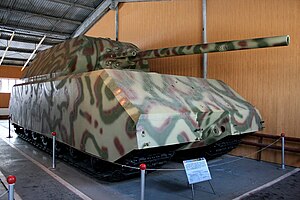Panzer VIII Maus
| Panzerkampfwagen VIII Maus | |
|---|---|

The Maus prototype at the Kubinka Tank Museum, Russia (2009)
|
|
| Type | Super-heavy tank |
| Place of origin | Nazi Germany |
| Production history | |
| Produced | 1944 |
| No. built | 2 (of which 1 incomplete) |
| Specifications | |
| Weight | 188 tonnes (207 short tons; 185 long tons) |
| Length | 10.2 metres (33 ft 6 in) |
| Width | 3.71 metres (12 ft 2 in) |
| Height | 3.63 metres (11 ft 11 in) |
| Crew | 6 |
|
|
|
| Armour |
220 mm (8.7 in) (turret front) |
|
Main
armament |
128 mm (5 in) KwK 44 gun L/55 (68 rounds) |
|
Secondary
armament |
75 mm (3 in) KwK 44 gun L/36.5 (co-axial) (100 rounds) 7.92 mm (0.31 in) MG 34 machine gun (co-axial) (1,000 rounds) |
| Engine | (V1) MB509 V12 petrol engine, DB 603 derivative (V2) MB 517 V12 diesel engine (V2) (V1) 1,080 hp (805 kW) (V2) 1,200 hp (895 kW) |
| Power/weight | 6.4 HP/ton |
| Ground clearance | 500 mm (20 in) |
| Fuel capacity | 2,700 litres (590 imp gal; 710 US gal) (internal fuel tank) 1,500 litres (330 imp gal; 400 US gal) (external fuel tank) |
|
Operational
range |
160 km (99 mi) (road) 62 km (39 mi) (off road) |
| Speed |
20 km/h (12 mph) (maximum) |
220 mm (8.7 in) (turret front)
200 mm (7.9 in) (turret side and rear)
200 mm (7.9 in) (hull front)
180 mm (7.1 in) (hull side)
20 km/h (12 mph) (maximum)
Panzerkampfwagen VIII Maus ("Mouse") was a German World War II super-heavy tank completed in late 1944. It is the heaviest fully enclosed armoured fighting vehicle ever built. Five were ordered, but only two hulls and one turret were completed before the testing grounds were captured by the advancing Soviet forces.
These two prototypes – one with, and the other without a turret – underwent trials in late 1944. The complete vehicle was 10.2 metres (33 ft 6 in) long, 3.71 metres (12 ft 2 in) wide and 3.63 metres (11.9 ft) high. Weighing 188 metric tons, the Maus's main armament was the Krupp-designed 128 mm KwK 44 L/55 gun, based on the 12.8 cm Pak 44 anti-tank field artillery piece also used in the casemate-type Jagdtiger tank destroyer, with a coaxial 75 mm KwK 44 L/36.5 gun. The 128 mm gun was powerful enough to destroy all Allied armoured fighting vehicles then in service, some at ranges exceeding 3,500 metres (2.2 mi).
The principal problem in the design of the Maus was developing an engine and drivetrain which was powerful enough to propel the tank, yet small enough to fit inside it — as it was meant to use the same sort of "hybrid drive", using an internal-combustion engine to operate an electric generator to power its tracks with electric motor units, much as its Ferdinand Porsche-designed predecessors, the VK 3001 (P), VK 4501 (P), and Elefant had. The drive train was electrical, designed to provide a maximum speed of 20 kilometres per hour (12 mph) and a minimum speed of 1.5 kilometres per hour (0.93 mph). However, during actual field testing, the maximum speed achieved on hard surfaces was 13 kilometres per hour (8.1 mph) with full motor field, and by weakening the motor field to a minimum, a top speed of 22 kilometres per hour (14 mph) was achieved. The vehicle's weight made it unable to utilize most bridges, instead it was intended to ford to a depth of 2 metres (6 ft 7 in) or submerge up to a depth of 8 metres (26 ft 3 in) and use a snorkel to cross rivers.
...
Wikipedia
